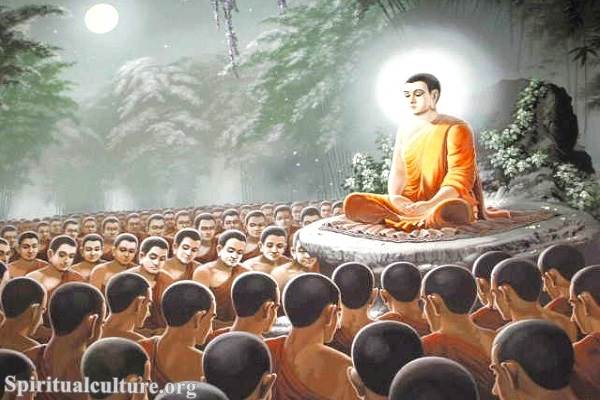I. What is Tibetan Buddhism?
Tibetan Buddhism is a form of Buddhism that is practiced in Tibet and surrounding regions in the Himalayas, including Bhutan, Ladakh, and parts of Nepal and India.
Tibetan Buddhism is also referred to as Lamaism, after the Tibetan word for teacher, lama.

Tibetan Buddhism combines Mahayana Buddhist philosophy with Tantric and Bon practices and is known for its rich spiritual and cultural traditions, including the use of mantra, visualization, and yoga-like physical exercises to achieve spiritual goals.
II. Tibetan Buddhism leader – Dalai Lama
The head of Tibetan Buddhism is the Dalai Lama, who is revered as both a spiritual and political leader.
The Dalai Lama is considered to be the reincarnation of the bodhisattva of compassion, Avalokiteshvara, and is therefore regarded as a living Buddha.
The Dalai Lama has both religious and political responsibilities and is widely respected as a global spiritual leader and advocate for peace, nonviolence, and human rights.
The current Dalai Lama, Tenzin Gyatso, is the 14th Dalai Lama and has been in exile since 1959 following the Chinese invasion of Tibet. Despite this, he continues to play a significant role in the preservation of Tibetan culture and religion.

III. Tibetan Buddhism beliefs
Tibetan Buddhism incorporates a wide range of beliefs and practices from Mahayana Buddhism and incorporates elements from the indigenous Bön tradition of Tibet. Some of the key beliefs of Tibetan Buddhism include:
- The Four Noble Truths: the reality of suffering, the cause of suffering, the possibility of ending suffering, and the path to the end of suffering.
- The Law of Karma: the belief that actions have consequences and that one’s present experiences are a result of past actions.
- Rebirth: the belief in the cycle of death and rebirth and the possibility of reaching liberation from this cycle through the attainment of enlightenment.
- Compassion: the central importance of compassion for all beings and the cultivation of a strong wish for their happiness and well-being.
- The Path to Enlightenment: the gradual practice of ethical conduct, meditation, and wisdom, leading to the attainment of Buddhahood.
Tibetan Buddhism also emphasizes the role of the guru or teacher, and the use of rituals, mantras, visualization, and physical exercises as tools for spiritual development. The ultimate goal of Tibetan Buddhism is to achieve enlightenment for the benefit of all beings.
IV. Tibetan Buddhism books
Tibetan Buddhism has a rich literary tradition, and there are many books that are considered important for study and practice within the tradition. Some of the most well-known and widely read books in Tibetan Buddhism include:
1. “The Dalai Lama’s Book of Wisdom” by Dalai Lama XIV
“The Dalai Lama’s Book of Wisdom” is a collection of teachings, reflections, and advice from His Holiness the Dalai Lama XIV, one of the most influential and revered spiritual leaders of our time. This book covers a range of subjects, including compassion, happiness, love, and spirituality. The Dalai Lama shares his insights on the nature of reality, the importance of inner peace, and the meaning of life. He also provides practical guidance on how to cultivate positive states of mind and deal with the challenges of daily life.
This book is a valuable resource for anyone seeking to deepen their understanding of Tibetan Buddhism and the teachings of the Dalai Lama. It offers a glimpse into the heart and mind of one of the world’s most inspiring spiritual leaders and provides inspiration for personal growth and transformation.
2. “The Tibetan Book of Living and Dying” by Sogyal Rinpoche
“The Tibetan Book of Living and Dying” is a seminal text in the Tibetan Buddhist tradition, written by Sogyal Rinpoche, a Tibetan teacher, and author. The book is a comprehensive guide to the practices and philosophy of Tibetan Buddhism, with a focus on the process of dying and the transition to the afterlife.
In the book, Rinpoche explores the nature of life and death, the cycles of birth and rebirth, and the path to enlightenment. He provides practical advice on how to cultivate a peaceful and meaningful life, and how to prepare for death and the afterlife. The book also includes teachings on meditation and mindfulness and provides guidance on how to support loved ones who are dying.
“The Tibetan Book of Living and Dying” has been widely acclaimed and has been translated into over 20 languages. It is considered an important resource for anyone interested in Tibetan Buddhism, spirituality, and personal growth, and is a timeless guide for living life to its fullest and facing death with courage and peace of mind.
3. “Buddhism in a Nutshell” by H.H. Dalai Lama
“Buddhism in a Nutshell” is a concise introduction to the teachings of the Buddha and the Buddhist path to enlightenment, written by His Holiness the Dalai Lama, one of the most revered spiritual leaders of our time. The book provides a brief overview of the fundamental principles of Buddhism, including the Four Noble Truths, the Eightfold Path, and the nature of reality.
In “Buddhism in a Nutshell”, the Dalai Lama explains the essence of Buddhist philosophy and practice in simple and accessible language, making it an excellent resource for those new to Buddhism. He also highlights the importance of compassion and mindfulness on the path to enlightenment and provides guidance on how to cultivate these qualities in daily life.
This book is an ideal resource for anyone seeking to gain a basic understanding of Buddhism and its teachings and is a valuable guide for anyone looking to deepen their spiritual practice and cultivate greater peace, happiness, and wisdom.
3. “The Essence of Tibetan Buddhism” by Geshe Kelsang Gyatso
“The Essence of Tibetan Buddhism” is a comprehensive introduction to the teachings and practices of Tibetan Buddhism, written by Geshe Kelsang Gyatso, a Buddhist teacher and founder of the New Kadampa Tradition. The book provides a clear and accessible overview of the key principles of Tibetan Buddhism, including the Four Noble Truths, the Eightfold Path, the nature of reality, and the path to enlightenment.
In “The Essence of Tibetan Buddhism”, Geshe Kelsang Gyatso explains the basic teachings of Tibetan Buddhism in simple and straightforward language, making it an ideal resource for beginners and those new to Buddhism. He also provides practical advice on how to incorporate Buddhist teachings and practices into daily life, and how to cultivate positive states of mind and develop compassion and wisdom.
This book is considered an essential resource for anyone interested in learning more about Tibetan Buddhism and is a valuable guide for those seeking to deepen their spiritual practice and cultivate greater peace, happiness, and understanding.
4. “The Power of Compassion” by Dalai Lama XIV and Victor Chan
“The Power of Compassion” is a book co-written by the 14th Dalai Lama, Tenzin Gyatso, and Canadian author Victor Chan. The book explores the concept of compassion and its importance in promoting peace and well-being in individuals and society. It offers insights and teachings from Buddhist philosophy, as well as practical advice for incorporating compassion into daily life. The book aims to inspire and guide readers on a journey toward compassion, and to show the transformative power that it can have on the world.
5. “Cutting Through Spiritual Materialism” by Chögyam Trungpa
“Cutting Through Spiritual Materialism” is a book written by Chögyam Trungpa, a Tibetan Buddhist meditation master, and teacher.
The book is based on a series of talks that Trungpa gave in the early 1970s, and it addresses the common pitfalls and misconceptions that can arise in spiritual pursuits. Trungpa argues that spiritual materialism occurs when individuals use spirituality as a means of ego-enhancement or self-aggrandizement, rather than as a path to true liberation and compassion.
“Cutting Through Spiritual Materialism” is considered a classic in the field of Tibetan Buddhism and is widely read and studied by students and practitioners of Buddhism. Its insights and teachings are still relevant today and offer a profound critique of the spiritual materialism that is all too common in modern spiritual practices.
6. “The Buddha’s Teachings on Prosperity” by Ven. Dhammika
“The Buddha’s Teachings on Prosperity” is a book written by Ven. Dhammika, a Buddhist monk and author.
The book focuses on how Buddhist teachings can be applied to the practical aspects of life, such as wealth and prosperity. The author explores the Buddhist understanding of material wealth and its role in the path to enlightenment, as well as the dangers of excessive attachment to wealth and material possessions. He also provides guidance on how to cultivate a healthy relationship with wealth, how to live a balanced and meaningful life, and how to develop a generous and giving heart.
The book offers a unique perspective on the intersection of spirituality and material prosperity and is aimed at helping readers to find greater peace, happiness, and fulfillment in their lives.
7. “The Essential teachings of the Four Noble Truths” by Geshe Tashi Tsering
“The Essential Teachings of the Four Noble Truths” is a book written by Geshe Tashi Tsering, a Tibetan Buddhist teacher, and scholar. The book is based on the Four Noble Truths, which are considered to be the foundation of Buddhist teachings. These Four Noble Truths are the truth of suffering, the truth of the cause of suffering, the truth of the end of suffering, and the truth of the path that leads to the end of suffering.
The author provides a comprehensive overview of these teachings and explains how they are relevant to modern life. He also offers practical guidance on how to apply the Four Noble Truths in daily life, in order to achieve greater peace, happiness, and liberation.
The book is written in a clear and accessible style and is suitable for both beginners and experienced students of Buddhism.
*Note: These Tibetan books cover a range of topics, from introductory guides to Buddhist teachings to more advanced texts on meditation and spiritual practices. They are widely available in libraries and bookstores, as well as in digital format.



